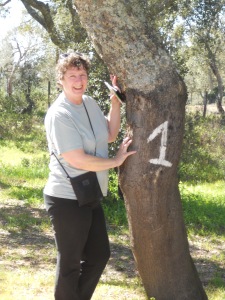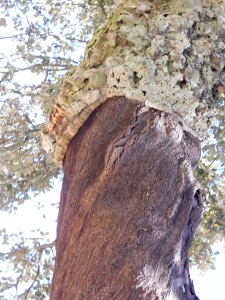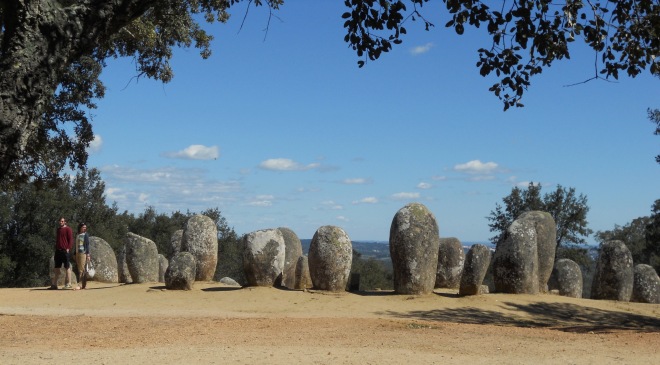When I was a youngster, I had my reckless moments. Like the time I was driving a two-wheeled cart pulled by my Shetland pony Firecracker. My hands were on the reins, I thought I was in control, but somehow Firecracker and the cart with me in it plowed over a newly planted maple tree in my parents’ backyard.
I caught hell that day, but in the long run, the experience taught me a lesson in resilience. Firecracker is in pony heaven, but that darn tree stands broad and erect outside my bedroom window.
During a visit to Provence, sycamores lining country roads etched a peaceful landscape in my mind. Imagine, coming back and finding 440 Hottenstein Road, soon-to-become Fleur-de-Lys Farm, with a giant sycamore standing in the meadow across from the barn.
So planning a trip to Portugal in search of cork oak trees is strange, but hardly out of character, and not at all difficult. If you visit the interior of southern Portugal, in the Algarve and Alentejo regions, it would be hard NOT to see miles and miles of cork trees. Groves of cork trees line the roads. They call attention to themselves, with stripped trunks that look like bare arms sticking out of wooly, lichen sweaters covering the upper branches of the canopy. Each bears a white number painted on the trunk—0 through 9.
Portugal’s Montados de Sobro–cork oak forests—are a mix of agriculture, forestry, pasture, culture, and history. Besides the many uses of the cork itself, the cork oak provides acorns for feed, its canopy shades grazing cattle, sheep or goats in the searing summer heat, and its leaf litter creates humus and replenishes the soil, preserving groundwater. Montados are a haven for wildlife, including 42 bird species. In a single square meter of one cork forest more than 60 plant species were recorded. Remote areas of the protected forests are home to the rare Iberian lynx. The first environmental laws in the world were passed in Portugal in the early 13th century to protect the cork oak forests.
A cork forest we stopped at outside Evora surrounded Cromeleque dos Almendres, the largest megalithic monument on the Iberian Peninsula, pre-dating Stonehenge by 2,000 years. Tinta picked up a thick coating of dust as Koen navigated a rutty rural road, but it was well worth it. Where else can you picnic, hug cork trees, hug towering granite stones erected in twin circles between 5,000 and 4,000 B.C., take all the photos you want—and see no more than a half dozen other visitors?
The bark from Quercus suber, the cork oak, has been harvested commercially in Portugal for the past 300 years. The tiradors, cork strippers, are the highest paid agricultural field workers in the world, earning 80-120 Euros/day plus benefits. They work in pairs, one up in the tree; the other, on the ground. With sharp, short-handled axes and in unison they delicately chop into the thick, spongy bark and together carve out door-sized rectangular slabs, almost like peeling an orange. The cork bark is dried for a couple months and then boiled in water to kill insects and bacteria, and to improve its flexibility.
When the cork is stripped correctly, the bark grows back and can be harvested in a decade. The cork oak is the only tree that can regenerate its bark. Cork peeling season starts in May with the new moon, and continues into summer. This year, each tree will be marked with white paint with a 6 for 2016 and most likely won’t be harvested again until 2026.
Newly planted cork oaks grow for at least 25 years before the first harvest. The first stripping is used for flooring and the second, a better grade, is used for other products—shoes, belts, wallets, cell phone holders—and the third and subsequent harvests are used for wine bottle stoppers. Each tree can be harvested for 200 years.
The structure of cork is similar to honeycomb—the cells work as sound and heat insulators, and absorb pressure and shock. Cork is light, impermeable to gas and liquid, elastic and compressible, fireproof, resistant to abrasion, and completely natural, renewable, and recyclable. What other material combines all of those characteristics?
In the 17th century, Dom Perignon decided the bark of the cork oak was perfect to seal his champagne and cork wine bottle stoppers took their place in history. Today, Portugal produces more than half of the cork in the world, and Portuguese cork is used in all the world’s greatest wines. However, the global financial crisis as well as the increased use of screw caps and plastic as wine stoppers, has hurt the cork industry. My environmental pledge for the future will be to drink more wine-and only buy bottles of wine topped with Portuguese corks. Laurie Lynch
“It began in mystery, and it will end in mystery, but what a savage and beautiful country lies in between.” Diane Ackerman

I had never though about where cork comes from. I am going to forward this to my kids. Very interesting.
Thank you, Valerie. I didn’t mean to confuse anyone with my comment about buying wine stopped with Portuguese cork. As far as I know, there is no way I know of telling, unless it’s Portuguese wine. The important thing in my mind is to buy wine with cork corks. 🙂 Laurie
There is only one kind of wine that I like – pink catawba from Clover Hill winery. It has a plastic cork. But it makes my legs get jumpy, so I don’t drink any wine.